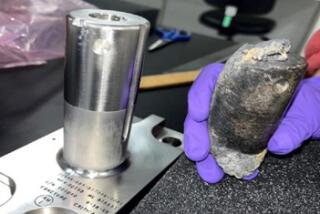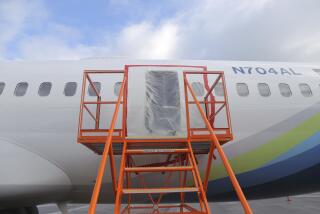Foam Bit Might Have Hit Right Wing
HOUSTON — On the day shuttle astronauts exchanged hugs and received a traditional Russian welcome of bread and salt after docking with the International Space Station, NASA said Thursday that more pieces of foam had come off Discovery during the launch and that one might have hit a wing.
The foam was one of three newly revealed pieces in images released by NASA. A space agency graphic showed the trajectory of one small piece arcing toward the right wing and then abruptly changing course. NASA officials said they were concerned that the debris might have hit the wing, as that was the cause of the Columbia disaster 2 1/2 years ago.
However, they said they were confident the foam was too small to have caused damage that would prevent Discovery’s safe return to Earth.
“That was the only piece that may have impacted the orbiter,” said N. Wayne Hale Jr., the deputy shuttle program manager. “We have assured ourselves it caused no damage.”
On Wednesday, NASA halted all future scheduled shuttle flights because a piece of foam with dimensions as great as 33 by 13 by 8 inches had come off the external fuel tank. The agency said flights were grounded until engineers could figure out what was causing the hard foam to fall off. At a Houston news briefing Thursday, managers said they did not know how long the shuttle fleet would be grounded.
Because the delay could be months or more, NASA is preparing to transfer more water and other cargo to the International Space Station than originally planned.
Hale said the agency also was considering extending by a day the orbiter’s stay at the space station, and therefore the mission. The shuttle crew might repair a balky treadmill on the station and bring back extra parts.
Despite the new concerns, NASA managers felt good enough about the safety of the orbiter and its seven-person crew to focus on what Hale called “a great day in space today for us.”
“We had a wonderful docking, very smooth and graceful,” he said.
Discovery docked at 4:18 a.m. PDT, as the station orbited over the South Pacific, 220 miles above Chile.
Crew members shook hands and hugged the station crew, Cmdr. Sergei Krikalev and flight engineer John Phillips.
Krikalev gave the visitors bread and salt, a traditional good-luck offering to travelers in Russia that means, “With bread I will not starve and with salt I will not die,” NASA said.
Discovery’s crew began unloading barrels of water and other supplies to the station. Today, the Italian-built Raffaello Multi-Purpose Logistics Module, which contains thousands of pounds of food and other cargo, is to be attached to the station.
Before docking, Discovery Cmdr. Eileen Collins performed the shuttle’s first-ever back flip so Krikalev and Phillips could snap photos of the orbiter’s underside, where a portion of a heat-resistant tile chipped off during launch.
The space station crew got 93 seconds’ worth of images. “Neither of us saw anything alarming,” Phillips said.
“Initial reports are everything looks extremely good and we don’t have anything to worry about” with the tile, flight operations director John Shannon said at a news briefing hours later, after the pictures had been downlinked to the Johnson Space Center.
However, the 400- and 800-millimeter camera lenses have limited ability to document the depth of a tile gouge.
The tiles near the nose landing-gear door, site of the biggest divot, are about 1.8 inches thick. A surface chip would be of little concern; shuttles have suffered tile dings throughout the program’s 24 years. But a deep cut could expose the underlying hull to the heat of reentry, threatening the craft’s structural integrity and the crew’s lives.
The temperature reached 5,000 degrees inside the damaged spot on Columbia’s wing.
Today the crew will use a new piece of equipment, the Canadian-developed Orbital Boom Sensor System, a 50-foot boom equipped with lasers, to inspect key areas of Discovery.
Inspection is nearly complete on the sensitive reinforced carbon material covering the leading edges of the shuttle’s wings and nose cone. That is where the highest temperatures are measured during reentry, and where the foam strike tore a hole in Columbia’s left wing. NASA officials said they found a scuff and coating damage on Discovery, but nothing they considered significant.
The orbiter sustained far fewer debris blows to the tile during the most recent liftoff than shuttles usually do.
On average, 150 nicks -- 31 of them larger than an inch -- mark the heat-resistant tiles covering most of the orbiter. Engineers have counted 31 altogether on this flight.
The record number of cameras and sensors on Discovery, which were added after the Columbia disaster, have enabled NASA to find potential problems that may have gone unobserved on the previous 113 flights.
The shuttle’s thermal protection problems have led some critics outside NASA to call for the agency to retire the shuttle fleet and wait for the next generation of spacecraft, to be built after 2010.
Hale said that spaceflight was “a tough business” but that the shuttle program would recover.
“We will fly successfully in the future,” he said.
The lead flight director, Paul Hill, said NASA’s line engineers refused to be distracted by the shuttle controversy. To them, the job is simple, he said: “It’s all about taking care of [Cmdr.] Eileen Collins and her crew.”
Hale said he had personally e-mailed the crew to apologize for the latest problems. “I told them I was frankly mortified at the performance of the foam and we would not fly again until we fix it,” he said.
He said he had not received a response before the crew went to bed Thursday.
Discovery’s commander appeared to be in a buoyant mood when she signed off at 1 p.m. PDT.
“It was a fantastic day, and we’re looking for a great one tomorrow,” Collins said. “Good night.”
More to Read
Sign up for Essential California
The most important California stories and recommendations in your inbox every morning.
You may occasionally receive promotional content from the Los Angeles Times.










